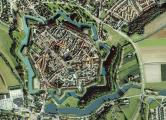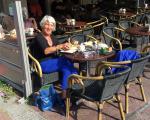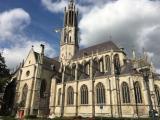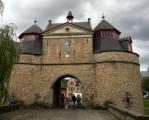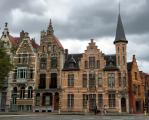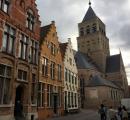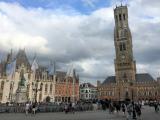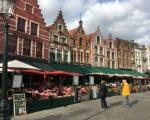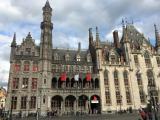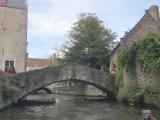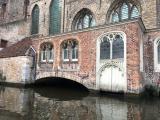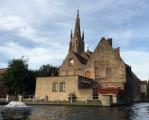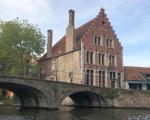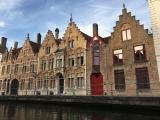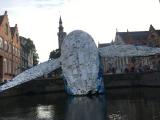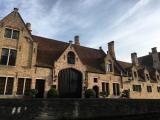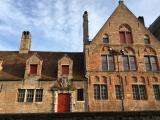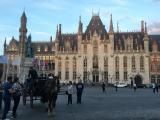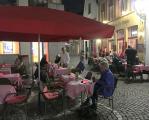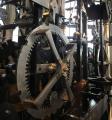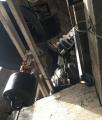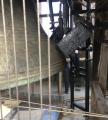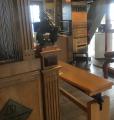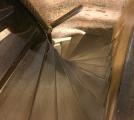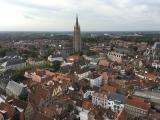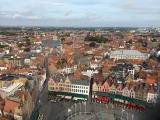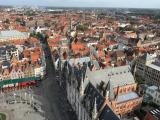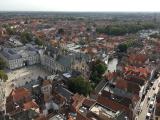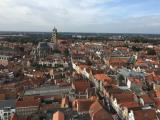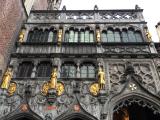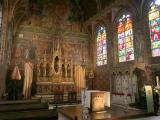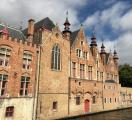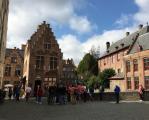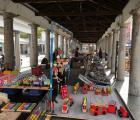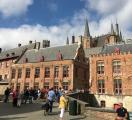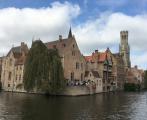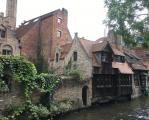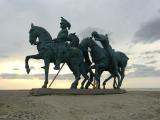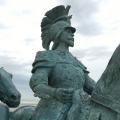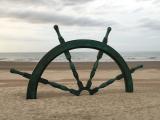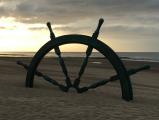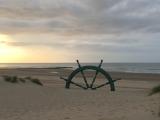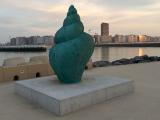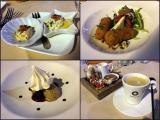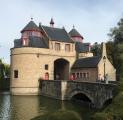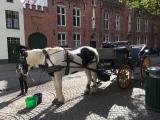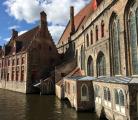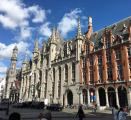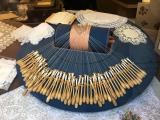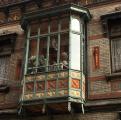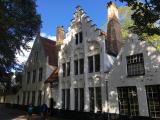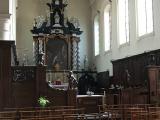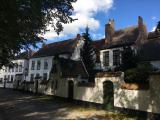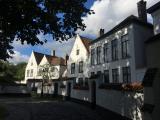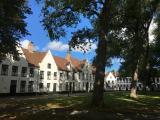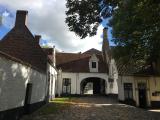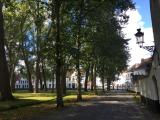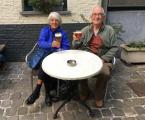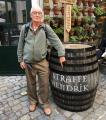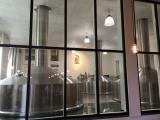Stuif's Adventures
| Brugge 2018 | ||||||||||||
| During my visits to the Netherlands, my soulmate Inez and I always try to organise a cultural outing. The last few years we have explored Dordrecht and Rotterdam in 2015, Amsterdam Architecture in 2016 and Museums in Den Haag in 2017. Where to go this year? As I stayed longer this time, we decided to make a 3D2N trip to Brugge in Belgium. Inez had visited this historical town already, for me it was a first. On our way we had coffee and lunch in Hulst, another historical town in the southern part of the Zeeland province. It is one of the few towns in the Low Countries where the walls and moats have survived almost intact. Note the spire of the basilica, it is a modern construction after the old one was destroyed in WWII. | ||||||||||||
| ||||||||||||
| In Brugge we had booked an Airbnb, a bit outside the historical center. Often the kitchen in an Airbnb contains already useful stuff, left by former guests, but this one was brand new, so after we arrived we first went to the nearby supermarket for provisions :-). Late afternoon we walked to the town center, entering through the Ezelpoort (Donkey Gate), passing nice buildings and churches, until we reached after about 15 minutes the Markt, the center of the town. | ||||||||||||
| The Markt is dominated by the Belfort (belfry), towering above the Stadhallen. Construction of the halls and bell tower goes back to the 13th century. Several times destroyed by fire, the octagonal upper tower was added between 1483 and 1487 . The Stadshallen were formerly market halls, and are now used for exhibitions and functions. Another impressive building is the Provincial Court, but don't be fooled, it is not as old as it looks! Built in 1294, demolished in 1787, replaced by a classicist building, that in the 19th century housed the Provicial Government. It burned down and was rebuilt in neo-Gothic style in 1887.
| ||||||||||||
|
A visit to Brugge is not complete without a boat trip through the reien (canals). It was already getting a bit late but the weather was nice and we could still book tickets for a half-hour trip. The skipper-cum-guide was entertaining and viewing the old buildings from the water gives a different perspective. A worthwhile excursion.
| ||||||||||||
| Back on the Markt, it was time for a refreshing beer. I tried a Brugse Zot (Fool of Bruges), one of the local beers. Not bad! We walked around a bit to find a quiet restaurant, not easy with the many tourists, but finally found a suitable terrace where we had local food, Vlaamse Stoverij (Beef stew cooked with beer). We had a last look at the belfry and the provincial court before we walked back through the Ezelpoort to our lodgings.
| ||||||||||||
| The next day we had breakfast in our temporary home, before we walked into the town again. Our first destination ws the belfry, we had decided to climb all 366 steps, to enjoy the view from the top. A steep climb, using a narrow spiral staircase. We passed the bells with its complicated machinery and the room where the carillonist was playing the carillon. That did not happen during our visit, but the ringing of the bells did, a deafening sound...:-) We were rewarded with a beautiful view of Brugge and its surroundings Then we had to descend the 366 steps again.
| ||||||||||||
| After climbing the Belfort, we walked to the Burg, near the Markt. The Burg square is the oldest part of Brugge, surrounded by beautiful buildings. First we visited the Basilica of the Holy Blood, built in 1134(!) by the Count of Flanders to house the Relic of the Holy Blood, which he had taken back from a Crusade. Two chapels, we only went to the upper one, originally built in Romanesque style but transformed into Gothic style at the end of the 15th century and "renovated" in the 19th century in Gothic Revival style.
The City Hall, next to it, is one of the oldest town halls of the Low Countries, built between 1367 and 1421 in Gothic style. Around 1900 the interior was completely redone in Gothic Revival style, like the Basilica. The concept of authentic restoration was apparently not yet invented...:-) But the result is beautiful. Another historical building at the Burg Square is the Brugse Vrije, we only had a look at the outside.
| ||||||||||||
Continuing our walk, we visited the fish market (now a tourist market), and the famous viewpoint at the Rozenhoedkaai.
| ||||||||||||
| We crossed the Bonifacius bridge, from where you have a good view of the Onze Lieve Vrouwe church, built in the 13-15th century. It is the tallest structure of Brugge, with a brickwork tower, which is the second tallest in the world! Real Gothic architecture here, nothing neo or revival :-) Nearby the medieval Sint Jans hospital, founded in the 12th century, now partly a museum.
| ||||||||||||
| We decided to keep the famous Begijnhof for the next morning and spend the afternoon to visit some modern artworks of the Beaufort Triennal. This is an art exhibition which is organised every three years along the Belgian coast. After a delicious dinner in Oostende we drove back to Brugge.
| ||||||||||||
After breakfast next day we went to the Begijnhof, on our way passing several buildings which had now become familiar to us. Tourists can make a trip in a horse-drawn carriage. Kantklossen (lace making) is a Brugse speciality, we saw a lady doing it in a shop window, but it was actually a puppet...:-)
| ||||||||||||
|
The Begijnhof of Brugge was founded in 1245, although many of the houses date from a later period, mostly 19th century. A Beguinage was a community of women who followed the example set by the apostles: poverty, simplicity and preaching. No vows, they were free to leave. Nowadays it is a community of Benedictine nuns. When you enter the Begijnhof through the ornamental gate , it is as if you enter a different world, far away from the hustle and bustle of the modern world. Almost automatically you will speak more softly.
| ||||||||||||
|
Before we drove back to the Netherlands, we had another beer at the Halve Maan brewery. I had tasted already the Brugse Zot. This time I took a Straffe Hendrik, a tripel beer. As my middle name is Hendrik, I had to try it of course. Not bad. Finally we had a portion of Vlaamse Frieten (Flemish fries) at one of the stalls in front of the Belfry. The guidebooks say that you must try them when you visit Brugge. Well, better don't. Expensive, unfriendly service and inferior quality. Look at Inez' face. To be avoided ! But all in all it was again a memorable trip, only too short, there is so much more to see in this beautiful town!
| ||||||||||||
|
